I have just bought some 555 timers and they are timers for microelectronic circuits...could anyone tell me what I need to search for in order to get larger ones which will fit a breadboard? Thanks
-
3You may have bought the 555 in a [SMD package](http://en.wikipedia.org/wiki/Surface-mount_technology), but you need it in a [DIP/DIL package](http://en.wikipedia.org/wiki/Dual_in-line_package) – m.Alin May 23 '12 at 19:01
-
2Why do you want a 555 timer? Starting a museum? Get some 741 opamps while you're at it to add to your collection. – Olin Lathrop May 23 '12 at 19:06
-
@m.Alin, post that as an answer. – kevlar1818 May 23 '12 at 19:29
-
7Also, @James, don't let them give you crap for buying 555 timers. They are very useful analog circuits, and great learning tools. – kevlar1818 May 23 '12 at 19:31
-
@kevlar1818 I don't want to be redundant; _The Photon_ already answered the question. – m.Alin May 23 '12 at 19:35
-
4Keep in mind that 555 timers are ancient archaic chips. There is little a 555 timer can do that a modern microcontroller can't to more accurately, with less power, and more repeatably. – Olin Lathrop May 23 '12 at 19:06
-
1For an EE help page, I'm surprised how much everyone shuns people who don't use microcontrollers in place of analog circuits. – kevlar1818 May 23 '12 at 19:31
-
I have programming skills...mostly in c++ and am just transitioning in to the electronics/microcontroller side of things... I am starting with the basics (what a capacitor does etc) and was hoping to build some simple circuits. – James Hatton May 23 '12 at 20:11
-
1@kevlar: But it is still useful to let people know that's not how it's done nowadays. Nothing is stopping someone from using a 555 timer, but if they are using a old hobby circuits book or something, they may have no idea how outdated those things are. Yes, you can learn with them, just like you can from vaccuum tubes, but you should also learn that technology has passed them by. – Olin Lathrop May 23 '12 at 21:07
-
5@OlinLathrop I think that the key is in the programming. You have tools, and know how to program them. But someone new to electronics does not have neither tools nor knowledge, so programming is like "climbing a mountain", for them. // Plus, I haven't used the 555 a lot, but I think it is a nice creature. Two analog comparators, an RS flip-flop, a discharge transistor and a high-current output stage. Good combination. That's a very versatile thing, for someone that is learning. – Telaclavo May 23 '12 at 23:00
-
4In a Le Mans start, I could breadboard a circuit to flash an LED with my choice of hardware faster than Olin could with a microcontroller. And I could make a two tone siren with fliding tone between (a la cop car siren in many araeas) faster than Olin could program one. And, Olin is utterly awesome. Even Olin could do the above faster with hardware :-). **BUT** beyond that level, the microcontroller wins. And, if you want to change the siren characteristics, or make them more coplex, the uC is far ahead. ... – Russell McMahon May 24 '12 at 04:01
-
... And if you want the LED flasher to change from on/off at 1 Hz say, to sending asynchronous serial data at 300 baud, say, the uC wins with an arm tied behind its back. Horses for courses - just keep the 555 course short :-). – Russell McMahon May 24 '12 at 04:01
-
1555 - number of the bistable – Stefan Paul Noack May 24 '12 at 06:40
-
@RussellMcMahon, although most of what you just discussed doing he could have used almost the exact same microcontroller for and done without any real hardware changes, just plugging in what he needs to control. You knew this though. – Kortuk May 24 '12 at 10:03
3 Answers
You want to look for a part in a "DIP" package.
- 126,425
- 3
- 159
- 304
-
1Damn short, but it's a complete answer. I can see nothing wrong in it. – stevenvh May 24 '12 at 14:28
-
4
-
1Wait wait wait this will always work if searching for ICs, but not always for some other parts like DIL switches. I have a DIL switch that was DIP but the pins were to short and thin to actually fit into the breadboard. You may need to mention that, where checking the datasheet for the pin length is important as well – Bradman175 Nov 05 '16 at 09:07
-
@Bradman175 The answer focused on OP's specific problem with the 555. You're welcome to add your own answer if you think this deserves more attention. ( – The Photon Nov 05 '16 at 17:02
OK, you know the answer from The Photon.
"DIP" package (a pleonasm) stands for "Dual In-line Package", also abbreviated to "DIL", for "Dual In Line". They have been used for 50 years, but they're used less now than 20 years ago.
Almost all DIPs have a 0.1", or 100 mils, pitch, the distance between the pins. Small DIPs are 300 mils wide, larger ones often 600 mils. In both directions that will fit in a breadboard, either a solderless or Veroboard style. You will have to press both rows together a bit.
Hobbyists often use DIP sockets when soldering.
They allow you to replace the IC without having to desolder it. There are also ZIF sockets (Zero Insertion Force), which are(were) for instance used in programmers where you have to insert and extract ICs all the time.
In recent years DIP has been replaced by SMDs (Surface Mounted Devices). They allow more compact products, are cheaper and offer technical advantages, like less inductance. You probably bought the SOIC (Small Outline IC) version of the LM555:
Other often used SMT (Surface Mount Technology) packages include the QFP (Quad Flat Package):
Many components are no longer manufactured in DIL packages, so you better get used to SMDs, both for ICs and discrete components:
- 145,145
- 21
- 455
- 667
-
Note that the compression factor between `DIP` and `DIL` is 1, so technically it's not an abbreviation ;) But there should exist also SMD to DIP sockets, just for completeness – clabacchio May 24 '12 at 13:08
-
How do smd products lower inductance? Isn't the integrated circuit itself the same size? – Gᴇᴏᴍᴇᴛᴇʀ Mar 12 '16 at 17:06
-
@Gᴇᴏᴍᴇᴛᴇʀ As the packages get smaller the leads get shorter, as do the bonding wires inside the IC. – bitsmack Jul 21 '16 at 18:57
DIP or any Through-hole technology part. For some SMD parts you can find so called "breakout boards", which allow you to attach wires (or even DIP-like pins) to them to use on a breadboard.
- 1,774
- 14
- 17
-
1[OT] You've been editing several answers today. You don't have to go into editing the answer if you just want to add a tag. Hover over the tags and you'll get a "edit tags" link. – stevenvh May 25 '12 at 14:25